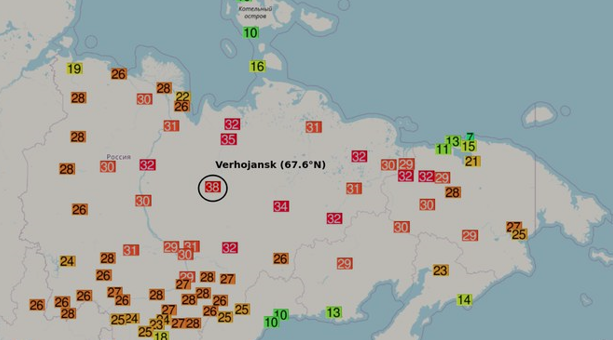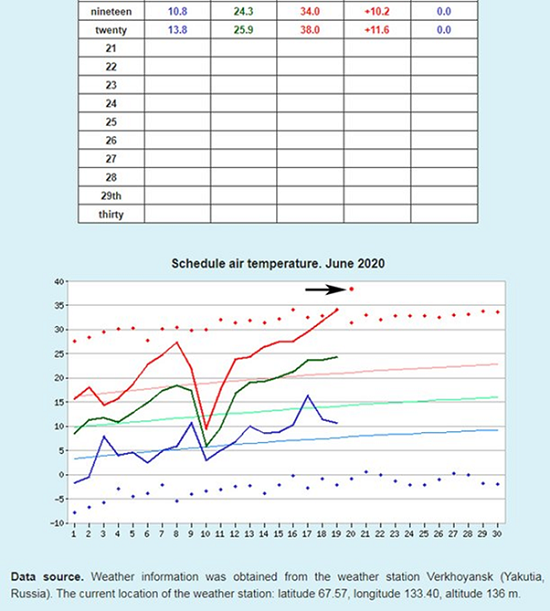The Arctic’s Hottest day? Not So Fast Michael Kile
“Last year, climate alarmists were beside themselves to alert the world that an all-time high temperature was scorching Antarctica. Just lately they’ve tried the same con with the Arctic, this latest claim no more credible than its predeccessor. It seems the only thing reaching new heights is the climateers’ shamelessness.”
Midsummer madness takes many forms. The combination of seasonal heat and light can produce eccentric behaviour when a global virus is hogging the headlines, such as the tendency to ramp up a single, yet-to-be-confirmed temperature measurement at a remote location – this time in northeast Siberia – into a climate scare.
Consider the media reaction to an alleged 38C reading on June 20, 2020 – “around 100 degrees Fahrenheit on the first day of summer” – at Verkhojansk, a Russian town ten kilometers inside the Arctic Circle (66°33′48.1″ north latitude), population about one thousand. It was like striking a match in a room full of hydrogen at the Hyperbole Club. From Helsinki to Kilkenny, from Scotland to Geneva, London and beyond, the MSM and Twitterati went wild with climate-angst (here, here and here).
Introducing the “unbelievably superhot” event on BBC’s Science in Action program five days later – Record high temperatures – in the Arctic – the presenter said: “It’s out of the COVID-pan and into the global warming fire.” Steve Vavrus, a University of Wisconsin climatologist, was one of the guests. Asked whether he was seeing “trends in the duration or regularity of these kind of persistent weather ratings”, Vavrus was even more emphatic:
This is connected to global warming. We’ve seen record warming for many years, if not most years of this decade. We know the Arctic is warming two to three times faster than the rest of the planet. One of the most important things to remember about this Arctic heatwave we’re experiencing right now is that it’s really not a fluke event. It’s an exclamation point on a long-term Arctic trend.”
Yet Verkhoyansk, even though an Arctic locatio (if only just), has exceptionally low winter temperatures and an extreme subarctic climate, one dominated by high pressure cells. The lowest temperature recorded there was −67.8 °C (−90.0 °F) on February 5 and 7, 1892; or January 15, 1885, if the plaque (atop this post) above is correct. Only Antarctica has recorded lower temperatures: its lowest at ground level is −89.2 °C (−128.6 °F), at the Vostok Station on July 21, 1983.
Verkhoyansk’s average monthly temperature ranges from −45.4 °C (−49.7 °F) in January to +16.5 °C (61.7 °F) in July. Mean monthly temperatures are below freezing from October through April and exceed +10 °C (50 °F) from June through August. It has never recorded a temperature above freezing between November 10 and March 14.
According to Wikipedia, “June, July, and August daytime temperatures over +30 °C (86 °F) are not uncommon” here. The warmest month on record is July 2001, at +21.9 °C (71.4 °F), at least until this year. The average annual temperature for the town is −14.5 °C (5.9 °F). If the June 20, 2020 temperature of +38.0 °C (100.4 °F) is confirmed, it would produce a record annual range of 105.8 °C (190.4 °F). Only Oymyakon, Yakutsk, Delyankir and Canada’s Fort Vermilion have ranges higher than 100 °C (180 °F).
The reading was trumpeted as “the highest temperature above the Arctic Circle ever recorded”. That Verkhojansk is a two-hour stroll – on land – inside it rarely got a mention.
Most commentators, predictably, went for a “global warming” angle. Few mentioned the g-word: geography. AccuWeather’s Senior Meteorologist Dave Samuhel was one of them (emphasis added).
Verkhoyansk has an incredible climate….The landlocked nature of the town is the main reason the temperatures are so extreme in both directions.
There is no body of water to bring milder air in. This works the other way in summer, being landlocked, so no cooler marine air can get in either.
And there is this as well from AccuWeather‘s Lauren Fox on June 23:
The location also receives sunlight 24 hours a day from May 30 through July 14, so the temperature is able to continue to rise so long as colder air from the north doesn’t blow in.
On the same day, June 23, the World Meteorological Organisation’s “fast-response evaluation team” announced its “tentative acceptance” of the temperature reading “as a legitimate observation”. However, it was – and is – still awaiting official confirmation from the Russian Federal Service for Hydrometeorological and Environmental Monitoring (Roshydromet).
Siberia had been experiencing “exceptional heat, with temperatures up to 10°C (18.5 °F) above average in May and driving the warmest May on record for the entire Northern hemisphere and indeed the globe”. Randall Cerveny, WMO’s Special Rapporteur on Weather and Climate Extremes, also issued a cautionary note.
Final information on whether this record maximum is for the whole area of the Arctic northward of Polar Circle needs to be assessed when more complete weather data is available.
Once WMO receives confirmation of the temperature from Roshydromet, it will then refer the finding for verification by a team of investigators for its Global Weather and Climate Extremes Archive (WWCEA). This provides details of global, hemispheric, and continental extremes (heat, precipitation etc).
As part of the verification process, WMO is contacting the Russian meteorological agency to collect direct information on the observation (such as the actual data, the type of equipment used, the quality-checks and calibration of the instrument, the observation monitoring techniques, the correspondence to surrounding stations, etc.)
Those data will then be very carefully examined by an international panel of atmospheric scientists. Fundamentally, these evaluations are very thorough and time-consuming projects.
WMO had not verified claims for the “highest temperature recorded north of Arctic Circle” in the past. However, “this extreme observation has garnered enough interest [in the media] that we are currently studying the creation of such a new category” for WWCEA.
Dr Cerveny, also professor of geographical sciences at Arizona State University, has been the WWCEA rapporteur – or record gatekeeper – since its formation 14 years ago.
On June 24, author Nick Lavars reported: “Arctic Circle records 100 degree temperature amid Siberian heatwave”.
The temperature was logged on June 20 by scientists at a meteorological station in the Russian town of Verkhoyansk, and usurps the previous highest temperature recorded at the facility of 37.3 °C (99.14 °F) in 1988. The station has recorded daily weather readings since 1885. (New Atlas, here)
The latest record, then – again assuming it is accurate and verified – is only 0.7 °C higher than that recorded here 32 years earlier, which to a reasonable person hardly seems to justify the current excitement. Fortunately, the concept of tendency evidence can assist us unravel the kerfuffle. In law it is used to prove that a person (or organisation) has or had a tendency to (i) act in a particular way; or (ii) has or had a particular state of mind.
Tendency evidence allows a jury – or reader — to reason that: he (she, they, or it) did it before; he (she, they, or it) has a propensity to do it; so the likelihood is that he (she, they, or it) did – or would do – it again: namely ramping a single yet-to-be-confirmed “record” temperature measurement into an international climate scare. Care must be taken, of course, to distinguish “tendency evidence” from “coincidence evidence”, that is evidence which uses the improbability of two or more events occurring coincidentally to “prove” that a particular act was performed while in a particular state of mind.
A reasonable person also might suppose that weather data – especially if it contains a “record” temperature – would flow (i) from the Verkhoyansk recording station to Roshydromet; (ii) from Roshydromet to WMO; and (iii) from WMO to the MSM and public, in a similar way that COVID-19 data flows to WHO, the World Health Organization.
Weather data, however, is different. Here is a provisional reconstruction of the Verkhoyansk data-flow for the week of June 20, 2020. It is subject to revision if and when more details are released by WMO, or uncovered by a cyber-sleuth.
Exhibit A: On June 20, Mika Rantanen, PhD, an extreme weather and climate change researcher at the Finnish Meteorological Institute tweeted:
Verhojansk, a Russian town in East Siberia known for its exceptionally cold winters, just broke its all-time heat record with a whopping 38.0°C (100.4°F)! Records kept since 1885. #ArcticHeatwave
Dr Rantanen included a map (below). He did not mention Verkhoyansk’s “landlocked nature”, or the halo of lower temperatures surrounding it.

Exhibit B: On June 20, 2020, Scott Duncan, a meteorologist in Scotland, Gàidhlig speaker and bagpipe player, retweeted the Rantanen tweet with this comment: “Just in… Blimey, that’s a big record to fall.”
Exhibit C: On June 21, 2020, Niall Dollard of Kilkenny Weather, Ireland, tweeted:
Verkhoyansk, Russia at 67.57 north has reported an incredible maximum temperature today of 38.0 C If verified, this is not only a record for the station but also the highest temperature ever observed north of the Arctic Circle. @AssaadRazzouk
Mr Dollard’s tweet included a graph of temperature readings apparently “obtained from Verkhoyansk (Yakutia, Russia)”. A black arrow points to the 38C reading, yet there is a red dot immediately below it at about 31C. What is going on here? Are there two readings for this crucial day?

Assaad Razzouk, one of Mr Dollard’s followers, was so excited by the news he tweeted:
Sorry to harp on (yet again) but this is historic: Verkhoyansk, Russian town in Arctic, reported an astonishing temperature today of 38.0°C (100°F) – not only a record but also likely highest temperature EVER recorded north of Arctic Circle
h/t @kilkennyweather #ClimateCrisis twitter.com/AssaadRazzouk/… (June 21)
For clarity: Freakish warming in Siberia = Melting Arctic = melting permafrost = continuous release of methane, potent greenhouse gas + continuous release of microbes frozen for hundreds of thousands years = more climate change + more pandemics. (June 22)
More on Siberia’s incredible, astonishing warming: Verkhoyansk, a Russian town in Arctic Circle was at 45°C (113°F) on 19 June 45°C in the Arctic 45°C in the Arctic 45°C in the Arctic Here I am, screaming: IT’S CLIMATE CHANGE, STUPID. (June 23)
Exhibit D: An online search of recent Verkhoyansk weather data — here — did not confirm a reading of 38C for June 20, 2020. The temperature on that day varied between 14C at 4am and 36C at 7pm. Weather today here
Exhibit E: On June 22, an unnamed person posted this message on UNFCCC’s Twitter account:
Temperatures reached +38°C within the Arctic Circle on Saturday, 17°C hotter than normal for 20 June. #GlobalHeating is accelerating, and some parts of the world are heating a lot faster than others. The #RaceToZero emissions is a race for survival.
Exhibit F: Scott Duncan again:
Oh my. Never thought I would see the day… The UN have just used my graphics. Heat will be in the news a lot this week (June 22)
Exhibit G: On June 23, the United Nations used the event to resuscitate its climate-scare campaign in a COVID-19 world: Extreme weather ‘record’ likely in Arctic Circle, says UN weather agency WMO
Clare Nullis of the WMO had this to say:
The WMO is seeking to verify reports of a new temperature record north of the Arctic Circle. It was reported in the Russian town of Verkhoyansk amid a prolonged Siberian heatwave and increase in wildfire activity. (WMO news video).
There was, of course, an fevered tweet from Secretary-General António Guterres too:
Temperatures in the Arctic Circle appear to have reached a record high over the weekend. Our planet is sending us a clear warning. The need for immediate and ambitious #ClimateAction is more urgent than ever.
aerial view of melting glaciers on King George Island, Antarctica. This latest report of an Arctic temperature more typical of the Tropics comes a few months after the Argentine research base, Esperanza, on the northern tip of the Antarctic Peninsula, set a new record temperature.
Wherever and whatever it is, it is not an aerial view. Antarctica is not the Arctic. As for the controversial Esperanza case, it is still awaiting resolution by WMO’s panel of WWCEA experts six months later.
See also: Antarctica’s ‘Hottest Day’? Not so Fast
Is the same game being played here? The Esperanza station is on an island outside the Antarctic Circle. Verkhoyansk is just ten kilometers inside the Arctic Circle. Yet both results have been hyped to give an impression that the “record” temperatures there (even if verified) somehow represent the geographical area inside each Circle.
Exhibit H: On 29 June, Dr Rantanen tweeted a link to an article published in Nature Climate Change the same day: “Record warming at the South Pole during the past three decades”. An “ensemble of climate model experiments” apparently has shown that, over the past three decades, the South Pole — presumably continental Antarctica — “experienced a record-high statistically significant warming of 0.61 ± 0.34 °C per decade, more than three times the global average.” Given the continent’s average temperature, it will be some time before it melts away.
The average annual temperature ranges from about −10°C on the Antarctic coast to −60°C at the highest parts of the interior. Near the coast the temperature can exceed +10°C at times in summer and fall to below −40°C in winter. (Australian Antarctic Division, February 18, 2019)
This “recent warming” apparently lies within the upper bounds of the simulated range of natural variability. Who would have thought there was an “intimate linkage of interior Antarctic climate to tropical variability”; or that such “atmospheric internal variability can induce extreme regional climate change over the Antarctic interior; or that it “has masked any anthropogenic warming signal there during the twenty-first century?” (Perhaps the answer lies behind NCC’s paywall.)
Exhibit I: On 2 July, 2020, in Geneva: a new “environmental dialogue” focusing on the Impact of #COVID19 on #Climate Science, with WMO, IPCC WG I, II & III, and UK (COP26).

Your Honour, my argument is simple. God has fashioned us in such a way that our original sin from birth is a craving attention. Yesterday’s hipsters are today’s hypesters. The phenomenon is perversely apparent today in many fields of endeavour, from street-fighting to meteorology and climate science.
As Professor Cerveny has said, if “the truth be told, world record extremes are mistakenly created all the time.”
For example a “fat finger” error such as hand digitizing a 28.0°C as 82.0 would create a world record observation that every quality control system would say was invalid. Additionally, instrumentation problems can generate a report far in excess of the meteorological conditions. But sometimes a combination of fairly extreme meteorological conditions with minor instrumentation problems, such as calibration errors, can necessitate considerable detective work to determine whether a new world record observation was indeed valid or not. Since weather records are often used as indicators that the Earth’s climate is changing and/or becoming more extreme, confirmation of new weather extreme records should be recognized as a high priority in the meteorology community.
One swallow may not a summer make, but two clangers at opposite ends of the Earth can make a climate alarmist’s dream – or nightmare – come true.
Comments are closed.
